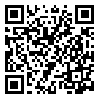Volume 3, Issue 4 (12-2014)
JCP 2014, 3(4): 563-572 |
Back to browse issues page
Download citation:
BibTeX | RIS | EndNote | Medlars | ProCite | Reference Manager | RefWorks
Send citation to:



BibTeX | RIS | EndNote | Medlars | ProCite | Reference Manager | RefWorks
Send citation to:
Youssefi A, Hajian Shahri M. Shot hole disease, survival and pathogenicity of the causal agent on stone fruit trees in Northeast Iran. JCP 2014; 3 (4) :563-572
URL: http://jcp.modares.ac.ir/article-3-264-en.html
URL: http://jcp.modares.ac.ir/article-3-264-en.html
1- Department of Plant Protection, Khorasan Razavi Agricultural and Natural Resources Research Center, Mashhad, Iran.
Abstract: (15574 Views)
Shot hole caused by Wilsonomyces carpophilus is one of the main constraints to prune fruit production in Iran particularly in Khorasan Razavi province. It causes foliage shot hole in spring and early summer; fruit-spotting and cankers on limbs and twigs during autumn rains. The fungus was isolated from the lesions of twigs and was purified on PDA. The pathogenicity and virulence on detached twigs of stone fruit tree species was examined in vitro. Virulence of the pathogen as measured by lesion length was significantly different among the different host species, showing the nectarine as the most susceptible species. In contrast to other hosts, sour cherry did not show any canker on shoots or twigs and disease progress was just as tissue colonization by the fungus hyphae. However, other species such as prune, cherry, apricot and almond did not show significant differences. The results of bud and shoot evaluations indicated that the fungus overwinters as hyphae and conidia in buds, and in the form of hyphae as well as thick-walled globular chlamydospores in twigs. Additionally, viability of recovered conidia ranged from 33 to 90% throughout the dormant season. A better understanding of disease cycle and survival mode of the fungus will help to manage and prevent the disease.
Received: 2013/03/24 | Revised: 2015/03/2 | Accepted: 2014/06/17 | Published: 2014/12/1
| Rights and permissions | |
 |
This work is licensed under a Creative Commons Attribution-NonCommercial 4.0 International License. |








